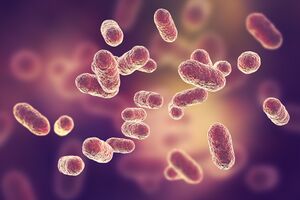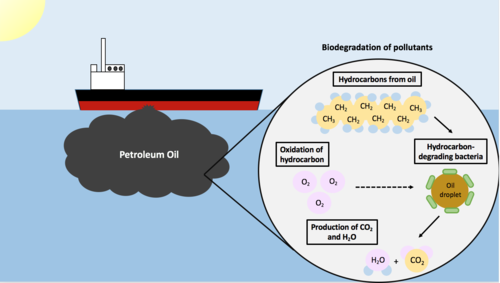Oil-Eating Bacteria: A Tool for Bioremediation: Difference between revisions
| Line 5: | Line 5: | ||
<br> Petroleum pollution is one of the most common pollutants in the world and is harmful to almost every species on Earth <ref name=oil4>[https://www.sciencedirect.com/science/article/pii/S235218641730264X Logeshwaran, P., Megharaj, M., Chadalavada, S., Bowman, M., Naidu, R.. (2018). Petroleum hydrocarbons (PH) in groundwater aquifers: An overview of environmental fate, toxicity, microbial degradation and risk-based remediation approaches. Environmental Technology & Innovation. 10: 175-193.]</ref>. Each year, three million tons of petroleum enters the ocean through activities such as oil-pumping, transportation, and more than half coming from prohibited activities and accidents <ref name=oil1>[https://doi.org/10.1111/j.1751-7915.2009.00151.x Brooijmans, R. J., Pastink, M. I., & Siezen, R. J. (2009). Hydrocarbon-degrading bacteria: the oil-spill clean-up crew. Microbial biotechnology, 2(6), 587–594]</ref>. Numerous studies have documented the negative consequences of petroleum pollution on organismal life. For example, petroleum has been found to interfere with the photosynthesis pathway of phytoplankton, which are the primary producers (base of the food chain) in marine environments <ref name=oil5>[https://doi.org/10.1016/j.chnaes.2009.12.002 Jiang, Z., Huang, Y., Xu, X., Liao, Y., Shou, L., Liu, J., Chen, Q., Zeng, J. (2010).Advance in the toxic effects of petroleum water accommodated fraction on marine Plankton. Acta Ecologica Sinica. 30(1): 8-15.]</ref>. Therefore, decreases in phytoplankton abundance caused by petroleum pollution could have bottom-up effects on the whole marine ecosystem <ref name=oil5>[https://doi.org/10.1016/j.chnaes.2009.12.002 Jiang, Z., Huang, Y., Xu, X., Liao, Y., Shou, L., Liu, J., Chen, Q., Zeng, J. (2010).Advance in the toxic effects of petroleum water accommodated fraction on marine Plankton. Acta Ecologica Sinica. 30(1): 8-15.]</ref>. Coral reefs are also negatively affected by petroleum, and a study by Turner and Renegar (2017) found that petroleum exposure can cause decreases in the abundance and diversity of coral by reducing growth rates, reproduction rates, and increasing tissue loss and death. Not only are marine environments affected by petroleum pollution, but terrestrial environments can also be affected through soil and groundwater contamination <ref name=oil4>[https://www.sciencedirect.com/science/article/pii/S235218641730264X Logeshwaran, P., Megharaj, M., Chadalavada, S., Bowman, M., Naidu, R.. (2018). Petroleum hydrocarbons (PH) in groundwater aquifers: An overview of environmental fate, toxicity, microbial degradation and risk-based remediation approaches. Environmental Technology & Innovation. 10: 175-193.]</ref>. Clean groundwater trapped in aquifers is a precious resource for humans, making the contamination of groundwater a serious issue <ref name=oil4>[https://www.sciencedirect.com/science/article/pii/S235218641730264X Logeshwaran, P., Megharaj, M., Chadalavada, S., Bowman, M., Naidu, R.. (2018). Petroleum hydrocarbons (PH) in groundwater aquifers: An overview of environmental fate, toxicity, microbial degradation and risk-based remediation approaches. Environmental Technology & Innovation. 10: 175-193.]</ref>. | <br> Petroleum pollution is one of the most common pollutants in the world and is harmful to almost every species on Earth <ref name=oil4>[https://www.sciencedirect.com/science/article/pii/S235218641730264X Logeshwaran, P., Megharaj, M., Chadalavada, S., Bowman, M., Naidu, R.. (2018). Petroleum hydrocarbons (PH) in groundwater aquifers: An overview of environmental fate, toxicity, microbial degradation and risk-based remediation approaches. Environmental Technology & Innovation. 10: 175-193.]</ref>. Each year, three million tons of petroleum enters the ocean through activities such as oil-pumping, transportation, and more than half coming from prohibited activities and accidents <ref name=oil1>[https://doi.org/10.1111/j.1751-7915.2009.00151.x Brooijmans, R. J., Pastink, M. I., & Siezen, R. J. (2009). Hydrocarbon-degrading bacteria: the oil-spill clean-up crew. Microbial biotechnology, 2(6), 587–594]</ref>. Numerous studies have documented the negative consequences of petroleum pollution on organismal life. For example, petroleum has been found to interfere with the photosynthesis pathway of phytoplankton, which are the primary producers (base of the food chain) in marine environments <ref name=oil5>[https://doi.org/10.1016/j.chnaes.2009.12.002 Jiang, Z., Huang, Y., Xu, X., Liao, Y., Shou, L., Liu, J., Chen, Q., Zeng, J. (2010).Advance in the toxic effects of petroleum water accommodated fraction on marine Plankton. Acta Ecologica Sinica. 30(1): 8-15.]</ref>. Therefore, decreases in phytoplankton abundance caused by petroleum pollution could have bottom-up effects on the whole marine ecosystem <ref name=oil5>[https://doi.org/10.1016/j.chnaes.2009.12.002 Jiang, Z., Huang, Y., Xu, X., Liao, Y., Shou, L., Liu, J., Chen, Q., Zeng, J. (2010).Advance in the toxic effects of petroleum water accommodated fraction on marine Plankton. Acta Ecologica Sinica. 30(1): 8-15.]</ref>. Coral reefs are also negatively affected by petroleum, and a study by Turner and Renegar (2017) found that petroleum exposure can cause decreases in the abundance and diversity of coral by reducing growth rates, reproduction rates, and increasing tissue loss and death. Not only are marine environments affected by petroleum pollution, but terrestrial environments can also be affected through soil and groundwater contamination <ref name=oil4>[https://www.sciencedirect.com/science/article/pii/S235218641730264X Logeshwaran, P., Megharaj, M., Chadalavada, S., Bowman, M., Naidu, R.. (2018). Petroleum hydrocarbons (PH) in groundwater aquifers: An overview of environmental fate, toxicity, microbial degradation and risk-based remediation approaches. Environmental Technology & Innovation. 10: 175-193.]</ref>. Clean groundwater trapped in aquifers is a precious resource for humans, making the contamination of groundwater a serious issue <ref name=oil4>[https://www.sciencedirect.com/science/article/pii/S235218641730264X Logeshwaran, P., Megharaj, M., Chadalavada, S., Bowman, M., Naidu, R.. (2018). Petroleum hydrocarbons (PH) in groundwater aquifers: An overview of environmental fate, toxicity, microbial degradation and risk-based remediation approaches. Environmental Technology & Innovation. 10: 175-193.]</ref>. | ||
<br> | <br> | ||
<br> Given the multiple consequences of petroleum pollution today, it appears that we desperately need an environmentally-friendly technique to remove petroleum from contaminated ecosystems. One such technique involves bioremediation, which is the use of microbes to convert toxic pollutants, such as anthropogenic petroleum, into non-toxic compounds | <br> Given the multiple consequences of petroleum pollution today, it appears that we desperately need an environmentally-friendly technique to remove petroleum from contaminated ecosystems. One such technique involves bioremediation, which is the use of microbes to convert toxic pollutants, such as anthropogenic petroleum, into non-toxic compounds <ref name=oil6>[https://doi.org/10.1016/j.techsoc.2010.10.010 Ezezika, O.C. and Singer, P.A. (2010). Genetically engineered oil-eating microbes for bioremediation: Prospects and regulatory challenges. Technology in Society. 32(4): 331-335.]</ref>. Recent scientific work has found that some bacteria (Oleispira, Oleiphilus, Thalassolituus, Alcanivorax and Cycloclasticus) can feed on petroleum due to their hydrocarbon‐degrading abilities <ref name=oil1>[https://doi.org/10.1111/j.1751-7915.2009.00151.x Brooijmans, R. J., Pastink, M. I., & Siezen, R. J. (2009). Hydrocarbon-degrading bacteria: the oil-spill clean-up crew. Microbial biotechnology, 2(6), 587–594]</ref>. Evolution has played a role in the formation of species capable of degrading petroleum. Petroleum oil is naturally found in environments from seeps in the seafloor and from fatty acids and lipids produced by plants and animals (Yakimov et al, 2007). To colonize these petroleum niches, some bacteria have evolved to produce enzymes capable of breaking down petroleum and using it as energy source for their metabolic pathways (Yakimov et al, 2007). Therefore, there is hope in the scientific community that we can utilize oil-degrading bacteria and enhance their abilities through genetic engineering to create a bioremediation tool to remove anthropogenic petroleum from polluted environments. | ||
Revision as of 14:30, 31 March 2021
Introduction
The use of petroleum, or crude oil, has been increasing since the industrial revolution [1]. The two common uses of petroleum are fuel and the synthesis of organic compounds [2]. Petroleum fuel is used as an energy source to provide many common-day luxuries, at least in the first world, such as heating and lighting for buildings and homes and for transportation by vehicles such as cars and planes [2]. Starting in 2000, petroleum was used to synthesize 99% of human-made organic compounds such as gasoline and kerosine [2]. Clearly, we rely heavily on petroleum and it is a ubiquitous chemical in our daily lives; however, there are a plethora of environmental consequences to such high petroleum consumption levels.
Petroleum pollution is one of the most common pollutants in the world and is harmful to almost every species on Earth [3]. Each year, three million tons of petroleum enters the ocean through activities such as oil-pumping, transportation, and more than half coming from prohibited activities and accidents [4]. Numerous studies have documented the negative consequences of petroleum pollution on organismal life. For example, petroleum has been found to interfere with the photosynthesis pathway of phytoplankton, which are the primary producers (base of the food chain) in marine environments [5]. Therefore, decreases in phytoplankton abundance caused by petroleum pollution could have bottom-up effects on the whole marine ecosystem [5]. Coral reefs are also negatively affected by petroleum, and a study by Turner and Renegar (2017) found that petroleum exposure can cause decreases in the abundance and diversity of coral by reducing growth rates, reproduction rates, and increasing tissue loss and death. Not only are marine environments affected by petroleum pollution, but terrestrial environments can also be affected through soil and groundwater contamination [3]. Clean groundwater trapped in aquifers is a precious resource for humans, making the contamination of groundwater a serious issue [3].
Given the multiple consequences of petroleum pollution today, it appears that we desperately need an environmentally-friendly technique to remove petroleum from contaminated ecosystems. One such technique involves bioremediation, which is the use of microbes to convert toxic pollutants, such as anthropogenic petroleum, into non-toxic compounds [6]. Recent scientific work has found that some bacteria (Oleispira, Oleiphilus, Thalassolituus, Alcanivorax and Cycloclasticus) can feed on petroleum due to their hydrocarbon‐degrading abilities [4]. Evolution has played a role in the formation of species capable of degrading petroleum. Petroleum oil is naturally found in environments from seeps in the seafloor and from fatty acids and lipids produced by plants and animals (Yakimov et al, 2007). To colonize these petroleum niches, some bacteria have evolved to produce enzymes capable of breaking down petroleum and using it as energy source for their metabolic pathways (Yakimov et al, 2007). Therefore, there is hope in the scientific community that we can utilize oil-degrading bacteria and enhance their abilities through genetic engineering to create a bioremediation tool to remove anthropogenic petroleum from polluted environments.

By
At right is a sample image insertion. It works for any image uploaded anywhere to MicrobeWiki.
The insertion code consists of:
Double brackets: [[
Filename: PHIL_1181_lores.jpg
Thumbnail status: |thumb|
Pixel size: |300px|
Placement on page: |right|
Legend/credit: Electron micrograph of the Ebola Zaire virus. This was the first photo ever taken of the virus, on 10/13/1976. By Dr. F.A. Murphy, now at U.C. Davis, then at the CDC. Every image requires a link to the source.
Closed double brackets: ]]
Other examples:
Bold
Italic
Subscript: H2O
Superscript: Fe3+
Alcanivorax borkumensis
Every point of information REQUIRES CITATION using the citation tool shown above.
Section 3
Include some current research, with at least one figure showing data.
Biodegradation Mechanism
Include some current research, with at least one figure showing data.

By
At right is a sample image insertion. It works for any image uploaded anywhere to MicrobeWiki.
The insertion code consists of:
Double brackets: [[
Filename: Biodegradation_of_Pollutants.png
Thumbnail status: |thumb|
Pixel size: |500px|
Placement on page: |right|
Legend/credit: Every image requires a link to the source.
Closed double brackets: ]]
Possible Use in Biotechnology
Conclusion
References
- ↑ Villela, H.D.M, Peixoto, R.S., Soriano, A.U., Carmo, F.L. (2019). Microbial bioremediation of oil contaminated seawater: A survey of patent deposits and the characterization of the top genera applied. Science of The Total Environment. 666: 743-758.
- ↑ 2.0 2.1 2.2 Eneh, O. C. (2011). A Review on Petroleum: Source, Uses, Processing, Products and the Environment. Journal of Applied Sciences. 11(12): 2084-2091.
- ↑ 3.0 3.1 3.2 Logeshwaran, P., Megharaj, M., Chadalavada, S., Bowman, M., Naidu, R.. (2018). Petroleum hydrocarbons (PH) in groundwater aquifers: An overview of environmental fate, toxicity, microbial degradation and risk-based remediation approaches. Environmental Technology & Innovation. 10: 175-193.
- ↑ 4.0 4.1 Brooijmans, R. J., Pastink, M. I., & Siezen, R. J. (2009). Hydrocarbon-degrading bacteria: the oil-spill clean-up crew. Microbial biotechnology, 2(6), 587–594
- ↑ 5.0 5.1 Jiang, Z., Huang, Y., Xu, X., Liao, Y., Shou, L., Liu, J., Chen, Q., Zeng, J. (2010).Advance in the toxic effects of petroleum water accommodated fraction on marine Plankton. Acta Ecologica Sinica. 30(1): 8-15.
- ↑ Ezezika, O.C. and Singer, P.A. (2010). Genetically engineered oil-eating microbes for bioremediation: Prospects and regulatory challenges. Technology in Society. 32(4): 331-335.
Authored for BIOL 238 Microbiology, taught by Joan Slonczewski, 2021, Kenyon College.
